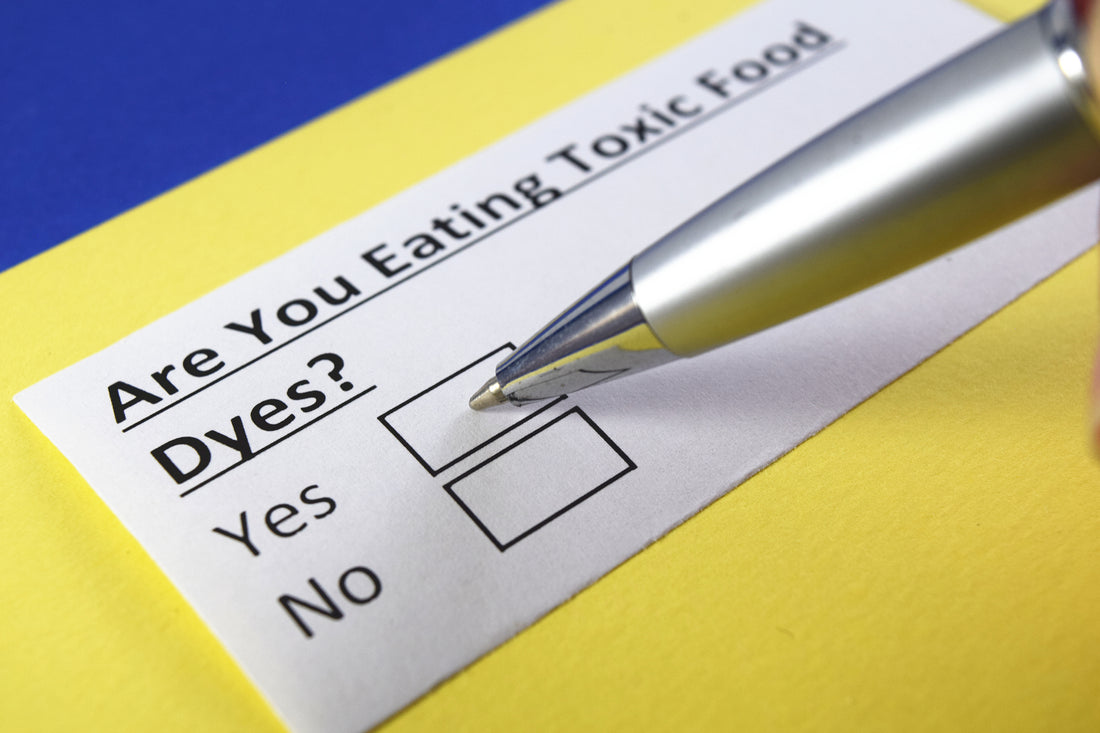Color food additives or food dyes are used to extend shelf life and make food more “brighter appealing” to the consumer, nevertheless, recent evidence emerges in the pursuit to find out the safety of these artificial additives that are added during preparation, production, and packaging.
More than 2500 chemical substances can be added to foods to modify flavor, color, and texture.
In this post, we are going to focus on color food additives and their relation to health.
COLOR ADDITIVES AND BRAIN HEALTH
Manufacturer products like Kraft Barbecue Sauce, Lasagna Hamburger Helper, Del Monte Fruit Salad, Nacho Cheese Doritos and even one aim to children’s consumption Trix Cereal, all of them contain Red Dye #40, and although it has been approved by the FDA, it has been banned in countries like Australia due to health concerns (1).
Other names for Red Dye #40 that you can find in food labels are Allura Red, Allura Red AC, C.I 16035, C.I Food Red 17, FD&C Red No. 40. Red 40 and Red No. 40.

Studies publish in medical journals such as Pediatrics, have linked artificial food dyes with ADD/ADHD (2) (attention deficit disorder) (attention deficit hyperactivity disorder), additionally, after ingestion food dyes can cause upset stomach, migraines and behavior changes.
Between 2004 and 2007 Southampton University published a study (3) in which children were given a diet added with color food additives, the results shown a higher hyperactivity rated by parents compared to placebo, the results of these studies led to some significant changes in the United Kingdom public health, requesting manufacturers to avoid these food additives.
ADDITIVES INTERACTION WITH NUTRIENTS
Nowadays food is processed much more extensively, these changes its nutritional profile, in addition to ADD/ADHD, food additives can limit the absorption of key micronutrients like zinc (4).

Zinc is an essential mineral it plays a role in antioxidant enzymes, brain function, and the immune system, among many other biological roles. A deficiency in zinc is related to delayed growth in youth and as well as general mental lethargy. Serum zinc concentrations are related to the risk of developing depression, and in children who are depressed zinc, status is further correlated with the severity of depression (5).
BE ON THE LOOKOUT
Knowing what you eat is essential, reading food labels for color food additives is a good way to avoid its consumption, be aware that even all food manufacturers are required to list them they do not have to specify the quantity, and as you may know from previous posts “the dosage makes the poison”, the level of concern may relay on how much milligrams are added, so our recommendation is to avoid as much as you can processed food that contains color food additives. The following list we provide includes the seven artificial food dyes used in the US:
- FD&C Blue No. 1 (Brilliant Blue FCF, E133) - BLUE SHADE TO FOOD
- FD&C Blue No. 2 (Indigotine, E132) - INDIGO SHADE TO FOOD
- FD&C Green No. 3 (Fast Green FCF, E143) - TURQUOISE SHADE TO FOOD
- FD&C Red No. 3 (Erythrosine, E127) - PINK SHADE TO FOOD
- FD&C Red No. 40 (Allura Red AC, E129) - RED SHADE TO FOOD
- FD&C Yellow No. 5 (Tartrazine, E102) - YELLOW SHADE TO FOOD
- FD&C Yellow No. 6 (Sunset Yellow FCF, E110) - ORANGE SHADE TO FOOD

Color food additives is a new topic of concern in medicine and especially nutrition, more research is needed to attend the effects of daily consumption and especially how much is too much, its impact in adults because literature have found a detrimental effect in children’s brain, our recommendation is to avoid them, especially in youths, the evidence suggests the negatives effects in brain and as such brain developments continues until the mid ’20s in average.
Natural non-artificial added substances are the way to go, in Wholefort we guarantee the high-quality nutritional profile of our cereals, everyone in your family can take advantage of the health benefits that bring quinoa, yacon, maca, and purple corn.

REFERENCES - Written by Antonio Reyes RDN
-
Burrows A. Palette of our palates: a brief history of food coloring and its regulation. Compr Rev Food Sci Food Saf 2009.
-
Nigg JT, Lewis K, Edinger T, Falk M. Meta-analysis of attention-deficit/ hyperactivity disorder or attention-deficit/hyperactivity disorder symptoms, restriction diet, and synthetic food color additives. J Am Acad Child Adolesc Psychiatry 2012.
-
McCann D, Barrett A, Cooper A, et al. Food additives and hyperactive behavior in 3-year-old and 8/9-year-old children in the community: a randomized, double-blinded, placebo-controlled trial. Lancet 2007.
-
Ward N, Soulsbury K, Zettel V, et al. The influence of the chemical additive tartrazine on the zinc status of hyperactive children a double-blind placebo-controlled study. J Nutr Med 1990.
-
Sánchez-Villegas A, Toledo E, de Irala J, Ruiz-Canela M, Pla-Vidal J, Martínez-González MA. Fast-food and commercial baked goods consumption and the risk of depression. Public Health Nutr 2012.


4 comments
cheap generic cialis
cialis generic cost
https://vsdoxycyclinev.com/ – doxycycline malaria buy online
Prix Du Kamagra En Belgique Doully buy online cialis Gopbilliap Amoxicillin And Clavulanate Potassium 600mg